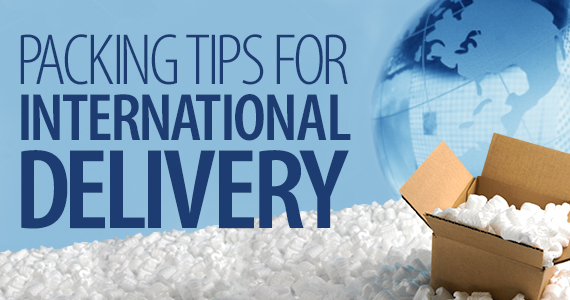 When shipping internationally, your packages require a little more care than if they were being shipped domestically, within the U.S. Remember, your package will be handled not only by your U.S. carrier, but also by your host country’s carrier, and handling facilities that aren’t always as sophisticated or regulated as they are here in the U.S. Your shipment could be battered, pushed, rolled or dropped during unloading, while moving through Customs, or in transit to its final destination. Attention to packing is an absolute must, and buyers take notice when you take extra care to ensure that their purchased items reach them in good condition. Here are some packing tips to ensure safe transit and satisfied international customers.
When shipping internationally, your packages require a little more care than if they were being shipped domestically, within the U.S. Remember, your package will be handled not only by your U.S. carrier, but also by your host country’s carrier, and handling facilities that aren’t always as sophisticated or regulated as they are here in the U.S. Your shipment could be battered, pushed, rolled or dropped during unloading, while moving through Customs, or in transit to its final destination. Attention to packing is an absolute must, and buyers take notice when you take extra care to ensure that their purchased items reach them in good condition. Here are some packing tips to ensure safe transit and satisfied international customers.
Getting Ready to Ship
Safe shipping starts at home! Follow these steps to get the journey started the right way.
- Choose the right box. For best results, use a new, preferably corrugated box that’s spacious enough to accommodate both your product and plenty of packing material on all sides. Ensure it’s strong enough to withstand the long trip and that all flaps are in good working order.
- Pay attention to weight. It’s tempting to max out the weight limit of your box, but resist. The magic number can usually be found on the bottom flap. If you’re reusing an old box, its strength may have been compromised from past shipment(s) – by as much as 30 to 60 percent! And remember, USPS’ maximum weight for packages is 70 pounds, and some countries mandate specific weight limits as well.
Prepare & Protect
- Filler up. Cushioning starts from the bottom up! Start with at least 5 centimeters of cushioning material – bubble wrap, packing peanuts and/or foam pads) before you even put your product inside the box. If it’s particularly heavy or valuable, bump up that amount even more. Make sure you reach all air pockets, too.
- Merchandise in multiples? Wrap and cushion each item separately so they don’t bump against each other in transit. Consider box-within-a-bunch for fragile items or products with finishes that could be easily scratched or dirtied, thereby doubling your protective measures.
- Insulate against the elements. Anticipate damage caused by extreme temperatures by wrapping and sealing your items.
- Shake it up. Before sealing your package, close and shake it. If you hear items shifting, add more filler until everything stays in place.
- Label inside. Put an additional copy of the shipping label (see below) inside the package before you seal it; ensure it has both your originating and destination addresses clearly indicated.
Special Considerations
For irregularly shaped items, confer with your shipper. Here are a few commonly shipped items that are oddly shaped or cumbersome to pack and tips for protecting them:
- Rolled fabric and wall coverings: Use corrugated boxes, or a tightly wrapped and taped bag.
- Electronics: Use anti-static materials, not foam packing, paper, or blankets. Include original factory packaging if possible.
- Printed matter: Shrink-wrap or band together printed items and include additional filler below and above in the shipping box.
- Artwork/antiques: Remove any glass and package it separately with specialty products like glass mask or glass-skin (unless it’s non-glare glass). Package the prepared glass separately. Make sure the artwork has no contact with paper, corrugate or hardboard, and don’t forget to include an appraiser invoice or statement.
- Breakable collectibles: Allow for at least 3 inches of cushioning around your item, and box/wrap multiples separately. Fill hollow centers with paper.
Label It
- Keep it clean. When reusing a box, remove, cover or black out all old markings and labels. Avoid paper wrapping on the outside of the box.
- No bulges. Make sure the package’s top surface is flat enough for routing and shipping labels; this also indicates which end is up.
- Tape. Seal all flaps and seams securely with wide (2- to 3-inch) nylon-reinforced or pressure-sensitive plastic tape — not masking, cellophane, duct or kraft-paper tape, or cord/rope/twine that could get tangled in sorting machinery. Remember, the heavier the package, the more tape you’ll need. Make sure to apply it tape in multiple directions – This will help make your package more durable during international transit.
- Write it right. Handwrite or print your label in uppercase letters, and be sure to include the full country name (no abbreviations) in English. (International addresses may be written in a foreign language, as long as the city, country and province are written in English as well.) Put the foreign postal code on the line above the destination country, and include your and your customer’s phone numbers if there’s space on the label. Make sure the bar code is visible and unwrinkled.
Customs Forms
- Form requirements. For packages up to 4 pounds and up to $400 in value, use PS Form 2976, or PS Form 2976 for shipments worth more than $400. They’re both available from your shipping center or via an online store like Stamps.com.
- Be accurate and specific. Complete all line items on the form accurately, paying special attention to the questions about the contents of your shipment, and don’t forget to sign it. Once completed, put the form in a clear adhesive envelope or pouch for easy access by carriers and officials; keep the sender’s copy in a safe place.
You’re all set to ship! Follow these packing tips, and before long, your package will arrive safely at its destination and reach a satisfied international customer.





